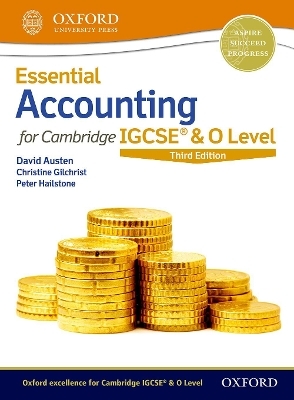
Essential Accounting for Cambridge IGCSE® & O Level
Oxford University Press
978-0-19-842483-3 (ISBN)
Ensure your EAL learners succeed in Accounting with a structured approach for the latest IGCSE & O Level (0452/7707) syllabuses, for examination from 2020.. Written by examiners, the step-by-step approach is fully aligned to the latest Cambridge syllabuses with a comprehensive mapping grid so you can be sure of complete support.
Embed comprehension for EAL students with topic guidance drawn from the syllabus and specialist vocabulary that is clearly highlighted and explained.
Ensure exam confidence with full support for the updated assessments including plenty of exam-style practice. This resource is also packed with numeracy based activities to develop students' calculation skills. while updated exam-style practice builds assessment confidence.
Engage students and link learning to real life with international case studies. Plus, Support learning with interactive tests, exam-style practice and Student Book answers on the accompanying support site.
A Workbook is also available, providing students with essential practice and mock exam papers.
Syllabus matching grid
The fundamentals of accounting
1.1: The accounting equation: assets, liabilities and capital
1.2: The accounting equation and simple statements of financial position
1.3: Preparing a classified statement of financial position
Practice questions
Source and recording data
2.1: The effect of transactions on items in a statement of financial position
Practice questions
2.2: Preparing simple ledger accounts
2.3: Preparing ledger accounts
2.4: Using expense, purchases, sales and drawings accounts
2.5: Getting used to the new accounts
Practice questions
2.6: The trial balance
Practice questions
2.7: Preparing simple income statements
2.8: Preparing the first part of the income statement
2.9: Preparing the second part of an income statement
Practice questions
2.10: How to balance accounts
2.11: How to close accounts
Practice questions
Source documents and books of prime entry
2.12: Source documents and credit purchases
2.13: Posting the purchases journal
2.14: Recording credit sales
2.15: Trade discount
Practice questions
2.16: Recording purchases returns
2.17: Recording sales returns
Practice questions
2.18: The two-column cash book
2.19: Cash discounts
2.20: The three-column cash book
Practice questions
2.21: The petty cash book
2.22: Recording petty cash payments
2.23: Preparing a petty cash book
Practice questions
2.24: The general journal
2.25: Making journal entries
Practice questions
Verification of accounting records
3.1: The trial balance and the correction of errors
3.2: Errors not revealed by a trial balance (part 1)
3.3: Errors not revealed by a trial balance (part 2)
3.4: Errors that are revealed by the trial balance
3.5: Correction profits and statements of financial position
Practice questions
3.6: Bank reconciliation statements
3.7: How bank statements are prepared
3.8: Comparing a cash book (bank columns) with a bank statement
3.9: The reconciliation process
Practice questions
3.10: Control accounts
3.11: Preparing sales and purchases ledger control accounts
3.12: Other entries in control accounts
3.13: More about preparing control accounts
Practice
Accounting procedures
4.1: Capital and revenue expenditure
4.2: Capital and revenue receipts
Practice questions
4.3: Accounting for depreciation and the disposal of non-current assets
4.4: How to calculate deprecation
4.5: Recording depreciation in accounts
4.6: Depreciation and the statement of financial position
4.7: Recording the disposal of a non-current asset
Practice questions
4.8: Other payables and other receivables: adjusting expenses
4.9: Other payables and other receivables: adjusting income
4.10: Preparing an income statement with adjustments to expenses and income
Practice questions
4.11: Irrecoverable debts and provisions for doubtful debts
4.12: Irrecoverable debts; recovery of debts written off
4.13: Provision for doubtful debts
4.14: Keeping a provision for doubtful debts up to date
Practice questions
4.15: The effect of inventory on gross profit
4.16: Valuation of inventory
4.17: More about income statements
Practice questions
Preparation of financial statements
5.1: Sole traders and financial statements
5.2: More about the statement of financial position
Practice questions
5.3: Partnerships: introduction
5.4: Sharing profits and losses
5.5: More about sharing profits and losses
5.6: Preparing the accounting records
5.7: Partnerships statements of financial position
Practice questions
5.8: Limited companies: introduction
5.9: Limited companies: background
5.10: Debentures; dividend calculations
5.11: Financial statements
5.12: Statement of changes in equity
5.13: Statement of financial position
Practice questions
5.14: Clubs and societies: background
5.15: Preparing a receipts and payments account
5.16: Subscriptions and revenue-raising activities
5.17: Statements of financial position
Practice questions
5.18: Manufacturing accounts: background
5.19: Preparing a manufacturing account
5.20: Manufacturer's financial statements
Practice questions
5.21: Incomplete records: background
5.22: Calculating profits and losses from minimal information
5.23: Preparing end-of-year financial statements from basic records
5.24: Using ratios to find missing figures
5.25: Preparing financial statements: illustration
Practice questions
Analysing and interpretation
6.1: Accounting ratios: introduction
6.2: Income statement and statement of financial position ratios
6.3: Interpretation of accounting ratios: introduction
6.4: Interpreting the income statement
6.5: Interpreting the statement of financial position
6.6: Interpreting a business's results
Practice questions
Accounting principles and policies
7.1: Accounting principles: introduction
7.2: Accounting principles: part 1
7.3: Accounting principles: part 2
7.4: Accounting principles: part 3
Practice questions
Glossary
Index
| Erscheint lt. Verlag | 17.5.2018 |
|---|---|
| Zusatzinfo | Colour |
| Verlagsort | Oxford |
| Sprache | englisch |
| Maße | 196 x 266 mm |
| Gewicht | 836 g |
| Themenwelt | Kinder- / Jugendbuch |
| Schulbuch / Wörterbuch | |
| ISBN-10 | 0-19-842483-3 / 0198424833 |
| ISBN-13 | 978-0-19-842483-3 / 9780198424833 |
| Zustand | Neuware |
| Haben Sie eine Frage zum Produkt? |
aus dem Bereich


